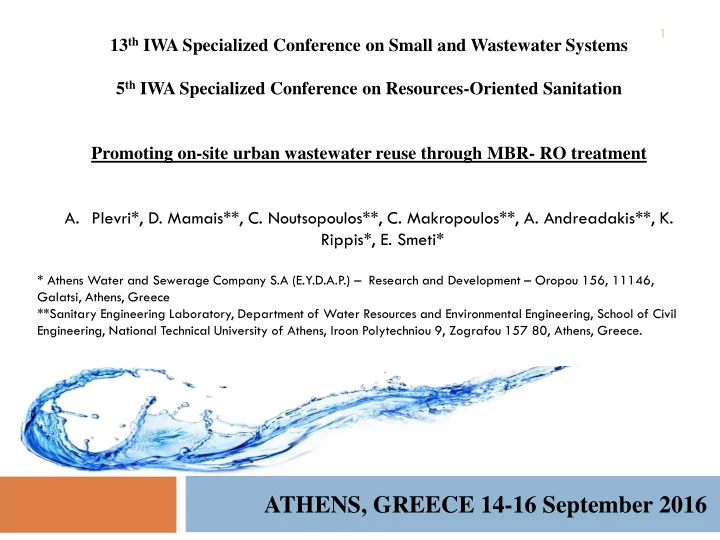

1 13 th IWA Specialized Conference on Small and Wastewater Systems 5 th IWA Specialized Conference on Resources-Oriented Sanitation Promoting on-site urban wastewater reuse through MBR- RO treatment A. Plevri*, D. Mamais**, C. Noutsopoulos**, C. Makropoulos**, A. Andreadakis**, K. Rippis*, E. Smeti* * Athens Water and Sewerage Company S.A (E.Y.D.A.P.) – Research and Development – Oropou 156, 11146, Galatsi, Athens, Greece **Sanitary Engineering Laboratory, Department of Water Resources and Environmental Engineering, School of Civil Engineering, National Technical University of Athens, Iroon Polytechniou 9, Zografou 157 80, Athens, Greece. ATHENS, GREECE 14-16 September 2016
PRESENTATION AIM&LAYOUT 2 Aims Present Athens DESSIN’s sewer mining unit Examine MBR-RO performance Confirm effluent water’s superior quality Cross validate results with Greek legislative framework Layout Introduction to Sewer Mining Athens demo site and SM unit presentation Operating parameters and quality monitoring Plotted results Conclusions
CURRENT SITUATION 3 Financial crisis Population growth Environmental degradation Rapid urbanization Water scarcity Climate variability There is a need for innovative management options and technologies for water reuse
SEWER MINING TECHNOLOGY 4 Sewer mining is the process of tapping into a wastewater system, and extracting wastewater, which is then treated and used as recycled water Compact sewer mining systems protect the environment in many ways, such as saving fresh water while creating green spots without further stressing the finite water resources, and all that in a cost efficient way
ATHENS UNIT 5 Innovations of Athens's SM unit: Irrigated area minimum landscape disruption close to the point-of-use Compact unit low transportation costs advanced sewage treatment R&D EYDAP methods fully independent function remote management of Metamorphosis , Athens several sewer mining units
DESCRIPTION OF THE PILOT-SCALE MBR-RO PROCESS 6 Membrane Bioreactor (MBR) Dual membrane process Reverse Osmosis (RO) MBR INLET ANOXIC SLUDGE AEROBIC
OPERATING PARAMETERS 7 Operation time 8 months Capacity 10 m 3 /d Temperature 15-25 o C MLSS in MBR tank 8-9g/l MLSS in anoxic-aerobic tank 6g/l Sludge Retention Time (SRT) 20d Operation cycle Quantity Duration 10 min filtration (g/cycle) (min) 1 min back flushing NaOCl (14%) 43 30 Maintenance cycles Citric Acid 340 40 1oxidizing cleaning per day (30%) 1 acid maintenance per week
MONITORING SYSTEMS 8 Low energy field sensors have been installed in several key points that upload data on a web platform ability of remote monitoring & real time alerting
LABORATORY ANALYSIS 9 Laboratory analysis is held at the ISO qualified laboratory for chemical and microbiological analysis in the Research and Development department of EYDAP : Ensures the unit’s proper function, by measuring key variables such as COD, CODs, SS, VSS, SVI, BOD, TP , TN, NH 4 -N + , NO 3 -N - , Cl - , TC, EC Makes a cross validation with the sensors’ measurements provision of feedback on the status of the sensor
PRIMARY PLOTTED DATA 10 COD of raw and pretreated Start-up period of the unit water
MBR PERFORMANCE AND PERMEATE QUALITY (1) 11 MBR performance in TSS MBR performance in COD
MBR PERFORMANCE AND PERMEATE QUALITY (2) 12 MBR performance in MBR performance in MLSS Ammoniacal Nitrogen
RO PERFORMANCE AND EFFLUENT QUALITY 13 Conductivity (left) and pH (right) data retrieved from the installed sensors
AGGREGATED RESULTS VS LEGISLATION 14 Mean Value (Standard Deviation) Legislation RO limits Parameters MBR effluent effluent (JMD 145116, 2011) ≤2 TSS (mg/L) <2 <2 VSS (mg/L) <2 <2 - COD (mg/L) 23(9,53) <10 - CODs (mg/L) 29(10) <10 - ≤10 BOD 5 (mg/L) 0,9 0,8 TP (mg/L) 5,9 (1,2) <0,5 ≤15 TN(mg/l) - 12(7,8) NH 4 -N + (mg/L) ≤2 0,25(0,32) - ≤100 for Cl - (mg/L) 172(75) 42(24) sprinkler irrigation ≤2 Turbidity (NTU) 0,32 (0,1) - Total Coliform ≤2 307 (393) ND (cfu/100ml) Faecal Coliform 1,09 (1,86) ND - (cfu/100ml) ≤5 E.Coli (cfu/100ml) 0,82 (0,98) ND
CONCLUSIONS 15 System presents high stability Sensors provide trustworthy data MBR Ideal pretreatment for the RO TMP remains steadily at low values no necessity for recovery cleaning Excess sludge: 7L for every m 3 of recovered water RO effluent fully met reuse water standards as dictated by the Greek legislation RO rejection rate has decreased by 15%, indicating that a chemical cleaning is necessary Total removal of COD and microbial pollutants Future steps: -Heavy metals, microorganic & priority pollutants -GHG emissions -System Optimization
ACKNOWLEDGMENT 16 The research leading to these results has received funding from the European Union Seventh Framework Programme under grant agreement no 619039 (ENV.2013.WATER INNO&DEMO-1), for the research project DESSIN "Demonstrate Ecosystem Services Enabling Innovation in the Water". The research and its conclusions reflect only the views of the authors and the European Union is not liable for any use that may be made of the information contained herein
Thank you for your attention 17
Recommend
More recommend